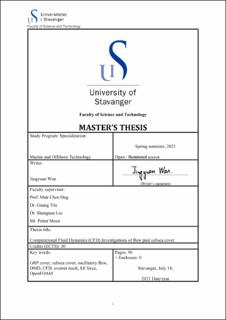| dc.description.abstract | Glass reinforced plastic (GRP) subsea protection covers are often used to protect offshore pipelines, umbilicals and other important subsea structures from dropped objects released from offshore oil and gas and fishing activities. These covers are often subjected to waves. The study of the GRP subsea cover under wave and current is a challenge, and it is the aim of this study to develop and build a numerical model that can be accurately simulated in response to the experimental implementation difficulties. This study performs a series of numerical simulations of the flow of different geometry structures under different flow condition at a series of KC numbers. The thesis is divided into three main procedures. The Chapter 5, 6 and 7 are the essential parts of this thesis and follow a sequence of modeling, revision, and analysis. In the present study, flows around an oscillating GRP subsea cover and oscillatory flows around a stationary subsea cover are investigated using numerical simulations at three different KC numbers of 5, 11 and 20, which are representative for low, medium and large KC number regions. For comparison, the solid structures of subsea cover are also investigated. The simulations of flows around an oscillating subsea cover are used to compare with the experiments done by SINTEF Ocean (formerly MARINTEK) and validate the present numerical model. This study mainly validates that the drag force and lift force acting on the static subsea cover subjected to the oscillatory flow can be used to predict the forces of flow on a moving subsea cover, which provides the foundation for further studies. It is found that the hydrodynamic forces for the two cases (flows around the oscillating cover and oscillatory flows around the stationary cover) are almost the same, which verifies that the experimental tests of subsea covers with forced motions can be used to study hydrodynamic forces on the stationary cover subjected to waves. The horizontal and vertical force coefficients and the surrounding flow fields around the covers are discussed. For further revision to improve lift forces with different geometry subsea covers is conducted. Three geometry categories are Case 1: cover only shell connected with domain respectively, Case 2: cover on the domain bottom and Case 3: subsea covers with baffles of different lengths. These cases discuss various aspects of the forces on the upper surface of the cover, the effect of the plate, and the effect of the water interaction inside the cover, for fully exploring the mechanism of the interaction between water flow and cover. Finally, the final numerical model that is the best match to the experimental data is determined. For this case, DMD post-processing will be performed to capture the dominant modes that determine flow filed and vorticity. | |
